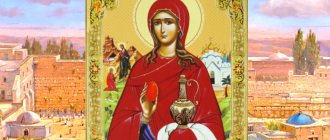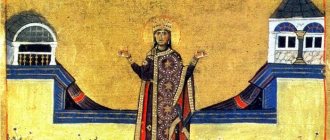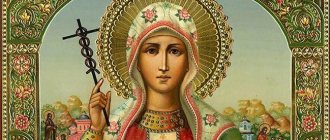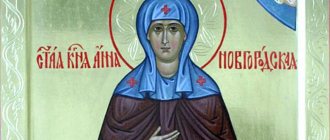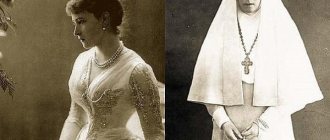The village of Krysovo is located on the southwestern side of Minsk. The local population does not exceed 100 people. However, many guests come here. The thing is that on the territory of the local cemetery there is the grave of Valentina Minskaya, the first Belarusian saint who was canonized as a blessed one.
Curriculum Vitae
Valentina Feodorovna Chernyavskaya was born on April 7, 1888. Her home village of Koski is located thirty-eight kilometers from Minsk.
Origin
The blessed one's father, Theodore Cherniavsky, was a clergyman. He was in charge of the parish of St. Nicholas Church in the neighboring village of Stankovo. Valentina's mother is Sofya Petrovna Svirskaya, bearer of the princely surname, an intelligent and educated woman.
Life
Valentina spent her childhood in her parents' house. She had three sisters. The mother raised her daughters according to the rules of piety and severity.
Basic facts of the worldly life of Blessed Valentina:
- studied at the Minsk Theological Women's School with her sisters;
- married Feodor Sulkowski, a collegiate adviser to the Minsk district administration;
- during the First World War she took typing courses and worked at the front as a typist;
- after the war, she and her husband ran their own household;
- in 1931 she lost her husband: Feodor Sulkowski came under repression as he came from a family of priests and was sent into exile. The husbands of Valentina's two sisters were also arrested and exiled, since they were clergy. None of them returned from the camps;
- survived the death of her father, who was seriously ill in recent years, but continued to lead services in the temple. Soon the mother also passed away;
- The year 1937 was marked by a new tragedy: all the clergy who remained in the Minsk diocese were shot. Among them were Valentina's last friends;
- After the confiscation of her parents' house, she lost her home and was forced to live in a church gatehouse.
In a cold room with an earthen floor, Valentina felt sick. Even before the death of her mother, the saint suffered from inflammation of the kidneys and lay in bed for a long time.
Valentina was helped by her husband's nephew. Alexander Sulkowski sent the saint a small amount of money every month. The woman gratefully kept the money transfer receipts until the end of her life. Valentina was also helped by her younger sister Olga. She did not marry, worked as the head of a Minsk school and sometimes gave the last of her funds to the sick.
Olga found the best refuge for Valentina - the house of neighbors Anton and Efrosinya Loiko, where the saint lived for the remaining thirty-three years.
Demise
Valentina spent many years bedridden, but not inactive. Blessed Xenia of Petersburg appeared to the saint in a dream and blessed him to serve God. Soon Valentina discovered the gift of foresight and healing.
As Matrona of Moscow, the woman was immobilized, but she saw with her inner gaze the events taking place far from her. And, like Ksenia of St. Petersburg, Blessed Minsk spoke in encrypted phrases that concealed deep meaning for those who knew how to listen.
Valentina perceives illness as God’s instruction to call for repentance, pray and give thanks for the suffering and mourning.
On February 6, 1966, the earthly journey of Valentina Sulkowskaya, née Chernyavskaya, ended. But the spiritual life of Blessed Valentina Minsk continued and will be eternal in the memory of people.
Life tests
She grew up in a Belarusian village, located in a picturesque place next to a river, in a spiritual, prayerful atmosphere with three other sisters.
They were raised as future mothers, taught prayers, obedience, and housekeeping. But the cruel time that crushed the fates of millions of people did not spare either Valentina Feodorovna or her family.
Her husband was exiled and died in the camp. She lost almost all her relatives and friends, since most of them belonged to the clergy and were exiled or shot. Her health, destroyed by a difficult life full of trials and cruel losses, completely left her, she fell ill.
Until 1937 she lived with her mother Sophia. Priests often came to their house for secret services. Even then, her fellow villagers considered her a saint. Soon, in 1939, the last functioning church in Minsk closed.
Iconography
Blessed Valentina of Minsk is depicted according to the traditions of the Orthodox Church:
- on a gold background;
- with a halo;
- in olive, blue clothes;
- in a white or blue headscarf;
- with an open left palm;
- with a palm branch in the right.
The blue color symbolizes holiness, and the white color symbolizes the purity of the soul. Blessed Valentina is the most revered saint in Belarus, along with Bishop Kirill of Turov and the blessed princess Euphrosyne of Polotsk. Their common icon was developed by the icon painters the Zharov brothers.
Behind the backs of the saints rises the main temple of Minsk - the Holy Spirit Cathedral. The central figure of the icon is the Bishop of Turov. On the right is Valentina Minskaya wearing a green cloak over a white long shirt and a white namitka, the national Belarusian headdress. The blessed one wore a namitka in life, so the scarf was made a traditional element of her iconographic image.
Veneration of Blessed Valentina of Minsk
Fellow villagers and residents of surrounding villages revered the healer as a saint during her lifetime - for her mercy, kindness, compassion and miraculous help. People who were closely acquainted with the blessed one spoke of her as an unusually kind person who was constantly in prayer.
Valentina was canonized in 2006. The saint became the first among the blessed of the Belarusian church. Every year, a festive service is held in the Church of St. Nicholas on the day of memory of Valentina Minskaya on February 6th. The service begins the day before with the All-Night Vigil. On Sundays and major Orthodox holidays, water blessing prayers are held at the saint’s burial place.
All crosses next to the grave of Valentina Minskaya are decorated with symbolic plants. For example, wheat means Christians, and ears of corn mean grace. In the summer, believers collect cornflowers and daisies, and dry flowers from their country gardens. Jewelry for Valentina is assembled according to sketches by local artist Georgiy Bigoza, who comes up with new compositions every year.
In 2020, an exhibition was held in memory of the blessed one at the Minsk Theological Academy. The exhibition consisted of photographs about the history of the veneration of Blessed Valentina. Rare footage captures moments from the life of the saint. Young artists from Ukraine, Belarus, Russia and Moldova, as part of the International Plein Air Art Show, showed their works dedicated to the oxbow lake.
Tatyana Dashkevich’s book “Holy Blessed Valentina of Minsk” tells about the life and miracles of the healer. Folk memories of her are retold in Russian. The instructive parables and figurative predictions of the saint are interesting for adults and children. So, before the outbreak of hostilities in 1942, Valentina described the iron “birds” in the sky - bombers. It is interesting that before the death of Joseph Vissarionovich, the saint also spoke about a black “bird” - it flew over Moscow and fell.
You can get to the grave by personal transport or by train.
How to get to my mother's grave? If you drive by car, the route will be as follows: if you drive from Minsk, then the cemetery where the blessed one is buried is on the right side.
Approximately 1.5 km after the overpass above the highway with the sign “Stankovo”. There will be signs at the cemetery, right up to the grave.
If you drive from Dzerzhinsk, then the cemetery is to the left of the highway 3 km after the overpass near the villages of Tsvetkovo-Kukshevichi.
If you go by train, you will have the following route: we get to Minsk, to the Pyatigorye station. Next you need to go past the holiday village, a small forest, the village of Krysovo to the local cemetery.
There will be signs indicating exactly where the grave is located. In any case, you can ask the local residents, they will always help.
They always bring a lot of flowers to mother’s grave
Holy Blessed Valentine pray to God for us!
By leaving a comment, you accept the user agreement
Location of the relics
The grave of Valentina Minskaya is located in the cemetery of the village of Krysovo, Dzerzhinsky district, Minsk region. The burial took place without a funeral service due to an anti-church ban. But the priest, dressed in civilian clothes, was quietly present among the large crowd of people wishing to say goodbye to the healer. At first, an ordinary cross and a fence were placed on the saint’s grave. Now it has a metal canopy or canopy, decorated with a forged vine, a dome and a cross.
The grave of Valentina Minskaya has historical and cultural significance. Therefore, it is not possible to transfer the saint’s relics to the capital. But the flow of believers does not stop. After all, before her death, the blessed one called to come to her for help, as if she were alive.
Valentina and her relatives very quickly lose their husbands - they end up under arrest in those years
In 1930, the collective farm “Awakening” was created. During the period of collectivization, Sulkowski also had to enroll in the collective farm.
Soon after this, carts walked through the village, collecting their harvest from all the peasants.
With the advent of such complete lawlessness, people begin to be arrested.
1933
in April of this year, Valentina has to say goodbye to her husband forever
Valentina's husband also falls under this arrest by mistake. He is sent to a camp, where he remains until April 1933.
Soon Theodore receives permission to be released and sent to Astrakhan. There he is arrested again, after which he is sent to the Far East, where he dies.
At the same time, other relatives of Valentina were also injured. Sister Anna’s husband, priest Vasily Stepura, was also arrested and exiled to Kazakhstan for three years.
Sister Ksenia’s husband, priest Sergius Rodakovsky, was sentenced to death.
Sergius Rodakovsky in 1999 was glorified among the holy new martyrs and confessors of the Minsk diocese.
Sergius Rodakovsky was glorified with the rank of martyr
Valentina was left without a husband. She begins to care for her mother, who was very ill.
All this greatly undermines the health of Valentina herself.
Valentina visited a sick woman who had been in bed for more than 40 years and she told her: “You will soon replace me.”
One day Valentina comes to see a woman who has been ill for a long time. She lay motionless for about forty years. She told Valentina, “You will soon take my place.” After this, another incident occurred that changed Valentina’s life forever.
What do they ask the Holy Mother for?
During her lifetime, Blessed Valentina called people to repentance. The guests who came to her for help were amazed at the power of the old woman’s prayer. She tried to awaken faith in every person. The saint did not help those who treated her as a witch and wanted instant results or miraculous healing without the desire for spiritual transformation. Therefore, prayers to Valentina will help those who are lost on the path to the truth, seeking forgiveness and atonement for sins.
During the Great Patriotic War, women came to Valentina with a request to protect their husbands and sons. The blessed one prepared a talisman for the men: she read a prayer over the scarves that their wives and mothers brought. The soldiers who carried the charmed scarves with them returned home safely. From heaven, Mother Valentina continues to protect her native believers who turn to her with prayer for protection.
The Minsk saint helps to find peace of mind in difficult life situations. She humbly endured hardships and losses. She is asked to strengthen her spiritual strength in order to accept the Will of the Lord.
In front of the image of Valentina Minskaya, they pray for healing from addictions, illnesses and for the birth of children. People come to the saint’s grave to talk about any problems and receive a quick resolution. After applying to the cross, diseases of the legs and eyes disappeared.
Valentina’s second incident at the stream radically changed her future life
One day Valentina went to the stream to wash her feet, suddenly she saw an amazingly beautiful woman. She told her, “Go and lie down.” Valentina did as the woman told her. She lay down and could no longer get up.
She spent 33 years in her bed until her death.
Surprisingly, for the rest of her bedridden life, she had no congestion or bedsores, as usually happens in such patients
The nephew of Valentina’s husband, Alexander Alexandrovich Sulkowski, showed great concern. Every month, together with his wife, he sent 100 rubles by postal order to Valentina’s family.
Mother Valentina collected all the coupons with these transfers, as a visual memory of how her husband’s family helped her during that most difficult time for them. Her sisters, who were also widowed, also helped as best they could.
1937
Valentina's mother died earlier this year
Valentina is completely orphaned. Her neighbors took care of her.
Valentina had to endure many things: the death of her husband, the death of her mother, as well as the death of many clergy of the Minsk Diocese.
But all these painful trials only strengthened her, and she took upon herself the feat of blessed service to God.
Soon many miracles began to happen. She predicted the First World War, saying: “We will have to see iron cannons...”.
During the war, wives came to her, sisters of men who were sent to the front to fight. They brought her scarves, which mother blessed and that was the only way everyone knew that their husbands would return home. And in fact they were returning.
Valentina lived the last year of her life with her sister Olga.
Valentina lived very modestly, lying on a small, modest bed. She also ate very little and also modestly.
Even the people who brought her food, she did not eat, saying: “You eat, and it’s easier for us who are sick to lie down.”
She gave advice to people who had not yet had time to ask their question.
2006
Blessed Valentina Canonized
Valentina died on February 6, 1966. Her grave is located in the rural cemetery of the village of Krysovo, Dzerzhinsky district, Minsk region.
Texts of prayers
- Troparion to Blessed Valentina of Minsk, tone 1:
- “From infancy, you received the faith of Christ in your heart, like a wise virgin, you carried its fruits through your entire life, and Christ also gave you the power to heal the ailments of the weak and wavering. Glorifying you, blessed mother Valentino, we cry out: glory to Him who gave you strength, glory to Him who glorified you, glory to Him who saves all who call on you.”
- Kontakion to Blessed Valentina of Minsk:
- “Chosen by God to preserve the Orthodox faith in the days of persecution on the lands of our Fatherland, we offer you songs of praise, our blessed mother Valentino. But you, who have boldness towards the Lord, deliver us from spiritual and physical evils.”
- Prayer to Blessed Valentina of Minsk:
- “Oh, our blessed mother Valentino! Just as in the days of your earthly life, you accepted with love all the suffering and infirm, everyone in sorrow and illness, and healed their ailments with your prayers. Likewise, now, ask the Lord for healing for everyone who comes to you with faith and tenderness, and especially save them from the falls of sin and guide them on the path of salvation. Hear us unworthy, blessed Valentino, and bring our prayers to the Throne of the Most High, so that with joy we may praise the Most Holy Trinity: the Father and the Son and the Holy Spirit, now and ever and unto ages of ages. Amen".
- Magnification:
- “We magnify you, our holy blessed mother Valentina, and honor your holy memory, for you pray for us to Christ our God.”
Marriage and life after the revolution
At the age of 24, Valentina married college adviser Fyodor Sulkowski, who was 20 years older than the girl. Her parents blessed the marriage with the Vladimir Icon of the Mother of God. This image, together with the face of Christ, given to Valya by the groom’s mother, was with her throughout her life.
During the First World War, the Sulkowski couple went to Poland, where the head of the family worked as an official in the military department and was involved in logistics support for the army. Valentina was accompanied abroad by her faithful assistant, fellow villager Efrosinya Loiko, who did not leave the woman even in the most difficult times.
After the revolution of 1917, the life of the Sulkowskis, as well as their relatives, changed tragically. Valentina's father died shortly after the Bolshevik religious persecution began, and found his final refuge near the church in Koski. The Chernyavsky family house and all other property were nationalized by the new government. After some time, husband Valentin was declared an enemy of the people. In 1931, Fedor was arrested, and 2 years later he was exiled and shot. Soon Valentina’s sisters, whose husbands belonged to the priestly class, also became widowed.
Left without her father and husband, Valentina began to live in Koski and take care of her elderly mother. During that period, her health also began to deteriorate and her kidneys became inflamed. At the end of the 20s. Valentina Fedorovna began to experience severe pain in her legs and could only move with the help of a stick.

